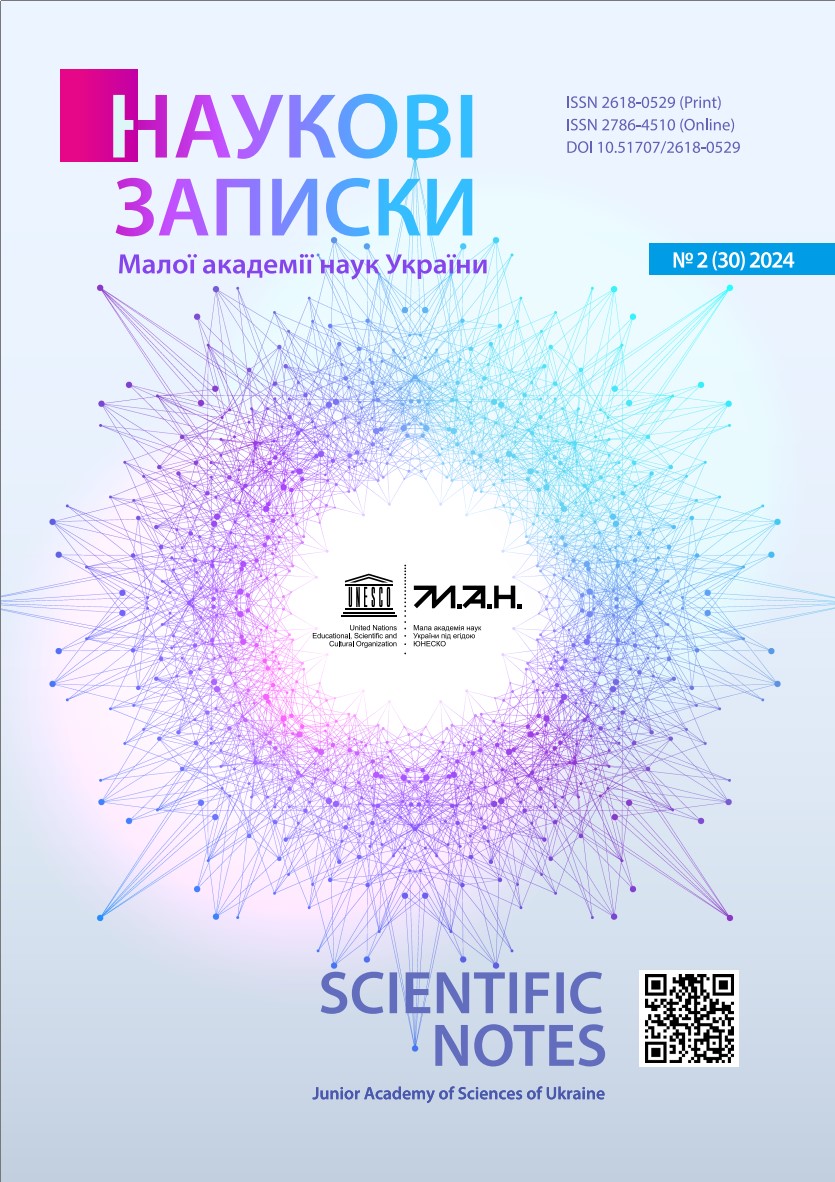Radioastronomic hardware complex of meteor monitoring for the STEM-center of the Junior Academy of Sciences of Ukraine
DOI:
https://doi.org/10.51707/2618-0529-2024-30-06Keywords:
radio astronomy, STEM, meteors, direct scattering method, antenna, SDR technologies.Abstract
The perspective of the development of radio astronomy for the virtual STEM center of the Junior Academy of Sciences of Ukraine is substantiated. This direction corresponds to the modern concept of STEM, as it has pronounced transdisciplinary connections with natural sciences, engineering, technology and mathematics. For the fullfledged existence and development of the field of radio astronomy in STEM education, a powerful practical part is necessary, which in turn requires certain equipment for its implementation. One of the areas of radio astronomy that does not require complex and expensive equipment is the observation of meteor phenomena using direct scattering on ionized meteor trails of signals from overthehorizon FM radio broadcasting stations in the range of 87.5 …108 MHz. A radio astronomical hardware complex for meteor monitoring, consisting of a receiving directional antenna, a radio frequency amplifier with an adjustable power injector, an SDR receiver RTL2832U + R820T2 and a computer with the necessary software, was designed, built and tested. During the tests of the complex, several meteor phenomena were registered synchronously with their visual observations, which testifies to its correct functioning. The created radio astronomy complex allows expanding the possibilities of educational astronomical observations, making them available at any time of the day. The use of SDR technology allows you to work with the complex remotely. Working with the hardware complex contributes to the development of a number of competencies related to natural sciences, radio reception technology, work with software, selection and adjustment of equipment, mathematical modeling and processing of experimental results. Radio complexes based on SDR technologies can be created and used also for other observations, for example, the study of radio radiation from Jupiter, the study of the passage of radio waves depending on the state of the ionosphere and solar activity, the observation of artificial satellites of the Earth, which can form the basis of the further development of the direction of radio astronomy in STEM education.
References
Malchenko, S. L., & Ivanova, A. I. (2019). Vyvchennia zorianykh suziriv z vykorystanniam elementiv STEM-osvity [Introduction of bright students using elements of STEM education]. Naukovi zapysky Tsentralnoukrainskoho derzhavnoho pedahohichnoho universytetu imeni Volodymyra Vynnychenka. Seriia: Pedahohichni nauky — Scientific notes of the Central Ukrainian State Pedagogical University named after Vladimir Vynnychenko. Series: Pedagogical sciences, 177 (1), 231–237 [in Ukrainian].
Malchenko, S. L. (2021). Vykorystannia STEM-proiektiv dlia vizualizatsii navchalnoho materialu z astronomii [Using STEM projects to visualize educational material on astronomy]. Zbirnyk naukovykh prats KamianetsPodilskoho natsionalnoho universytetu imeni Ivana Ohiienka. Seriia Pedahohichna — Collection of scientific works of KamianetsPodilskyi National University named after Ivan Ohienko. Series Pedagogical, 27, 77–81. DOI: https://doi.org/10.32626/2307-4507.2021-27.77-81 [in Ukrainian].
Virtualnyi STEM-tsentr Maloi akademii nauk Ukrainy [Virtual STEM-center of the Junior Academy of Sciences of Ukraine]. stemua.science. Retrieved from https://stemua.science/ [in Ukrainian].
Science Buddies. Retrieved from https://www.sciencebuddies.org/.
Meteor Echo Detection With Radios. Retrieved from https://www.meteorecho.com/p/blog-page.html.
Abidin, Z. Z. (2011). Radio meteor detection in Malaysia. International Journal of Fundamental Physical Sciences, 1, 3, 53–56. DOI: https://doi.org/10.14331/ijfps.2011.330013.
International Meteor Organization. Practical Information. Retrieved from https://www.imo.net/obser-vations/methods/radio-observation/practical/.
Bushuev, F. I., Kaliuzhnyi, M. P., Kulichenko, М. О., Shulga, О. В., Malynovskyi, Yе. V., Savchuk, S. G. et al. (2021). Stanovlennia ta rozvytok ukrainskoi merezhi radiosposterezhen meteoriv [Formation and development of the Ukrainian network of radio observations of meteors]. Kosmichna nauka i tekhnolohiia — Space science and technology, 27, 3, 85–92. DOI: https://doi.org/10.15407/knit2021.03.085 [in Ukrainian].
Lesanu, C., Done, A., Cailean, A., & Graur, A. (2018). Vertical polarized antennas for low-VHF radio meteor detection. 14th International Conference on Development and Application Systems (DAS). IEEE, May, 18. (Pр. 93–98). Suceava, Romania. DOI: https://doi.org/10.1109/DAAS.2018.8396078.
Chiwate, S., Zhang, Z., Mernick, K., Shen, B., Vavilov, D., Bugallo, M. et al. (2009). SDR-based radar system for meteor detection. 2009 16th International Conference on Digital Signal Processing. IEEE, July, 09. (Pр. 1–6). Santorini, Greece. DOI: https://doi.org/10.1109/ICDSP.2009.5201236.
Hrudynin, B., & Vidmachenko, A. (2023). Orhanizatsiia roboty ukrainskoi meteornoi sposterezhnoi merezhi (UMSM) na osnovi vykorystannia syhnaliv transliuvalnykh FM-stantsii [Organization of the work of the Ukrainian meteor observation network (UMON) based on the use of signals from broadcast FM stations]. Fizykomatematychna osvita — Physical and Mathematical Education, 38, 1, 14–19. DOI: https://doi.org/10.31110/2413-1571-2023-038-1-002 [in Ukrainian].
Çubuk, K. O., Terzioğlu, C., Kayıhan, H. A., Selmaoğlu, M., Bulut, S., & Özeren, F. (2012). Radio observations and evaluation of the meteor showers between May 4 and August 25, 2012. Proceedings of the International Meteor Conference. IMO, September 20– 23. (Рр. 1–3). La Palma, Canary Islands, Spain.
Leite, E., Alves, G., Seixas, J., Marroquim, F., & Takai, H. (2011). Radar Meteor Detection: Concept, Data Acquisition and Online Triggering. Wave Propagation. InTech, 537–552. DOI: https://doi.org/10.5772/14149.
FMSCAN — frequencies and transmitter maps for any place. Retrieved from https://fmscan.org/helpen.htm.
Downloads
Published
How to Cite
Issue
Section
License
Copyright (c) 2024 Scientific notes of Junior Academy of Sciences of Ukraine

This work is licensed under a Creative Commons Attribution 4.0 International License.













